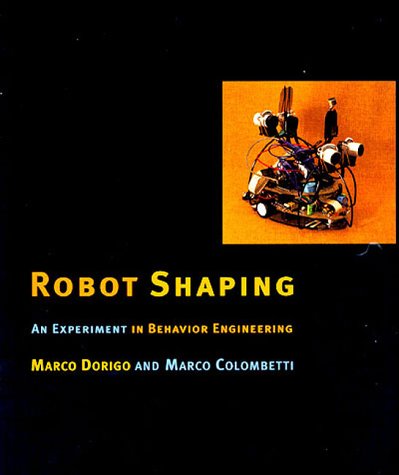Robot Shaping: An Experiment in Behavior Engineering (Intelligent Robotics and Autonomous Agents) - Hardcover

Synopsis
foreword by Lashon Booker
To program an autonomous robot to act reliably in a dynamic environment is a complex task. The dynamics of the environment are unpredictable, and the robots' sensors provide noisy input. A learning autonomous robot, one that can acquire knowledge through interaction with its environment and then adapt its behavior, greatly simplifies the designer's work. A learning robot need not be given all of the details of its environment, and its sensors and actuators need not be finely tuned.
Robot Shaping is about designing and building learning autonomous robots. The term shaping comes from experimental psychology, where it describes the incremental training of animals. The authors propose a new engineering discipline, behavior engineering, to provide the methodologies and tools for creating autonomous robots. Their techniques are based on classifier systems, a reinforcement learning architecture originated by John Holland, to which they have added several new ideas, such as mutespec, classifier system energy, and dynamic population size. In the book they present Behavior Analysis and Training (BAT) as an example of a behavior engineering methodology.
"synopsis" may belong to another edition of this title.
About the Author
Marco Dorigo is a research director of the FNRS, the Belgian National Funds for Scientific Research, and co-director of IRIDIA, the artificial intelligence laboratory of the Université Libre de Bruxelles. He is the inventor of the ant colony optimization metaheuristic. His current research interests include swarm intelligence, swarm robotics, and metaheuristics for discrete optimization. He is the Editor-in-Chief of Swarm Intelligence, and an Associate Editor or member of the Editorial Boards of many journals on computational intelligence and adaptive systems. Dr. Dorigo is a Fellow of the ECCAI and of the IEEE. He was awarded the Italian Prize for Artificial Intelligence in 1996, the Marie Curie Excellence Award in 2003, the Dr. A. De Leeuw-Damry-Bourlart award in applied sciences in 2005, the Cajastur Mamdani International Prize for Soft Computing in 2007, and an ERC Advanced Grant in 2010.
"About this title" may belong to another edition of this title.
Search results for Robot Shaping: An Experiment in Behavior Engineering...
Robot Shaping: An Experiment in Behavior Engineering (Intelligent Robotics and Autonomous Agents)
Seller: Phatpocket Limited, Waltham Abbey, HERTS, United Kingdom
Condition: Good. Your purchase helps support Sri Lankan Children's Charity 'The Rainbow Centre'. Ex-library, so some stamps and wear, but in good overall condition. Our donations to The Rainbow Centre have helped provide an education and a safe haven to hundreds of children who live in appalling conditions. Seller Inventory # Z1-B-005-02105
Buy Used
Ships from United Kingdom to U.S.A.
Quantity: 1 available
Robot Shaping: An Experiment in Behavior Engineering (Intelligent Robotics and Autonomous Agents)
Seller: Bellwetherbooks, McKeesport, PA, U.S.A.
hardcover. Condition: Very Good. Very Good Condition - May show some limited signs of wear and may have a remainder mark. Pages and dust cover are intact and not marred by notes or highlighting. Seller Inventory # mon0000009246
Robot Shaping: An Experiment in Behavior Engineering
Seller: BRIMSTONES, Lewes, United Kingdom
Hardcover. Condition: Very Good. Dust Jacket Included. hardback, 4to, xviii,203pp, illustrated, owner's name in pen and pencilled inscriptions on front endpaper, contents clean and sound, Very Good / Very Good dustwrapper. ISBN: 0262041642. Seller Inventory # 786432
Buy Used
Ships from United Kingdom to U.S.A.
Quantity: 1 available
Robot Shaping. An experiment in behavior engineering.
Seller: Antiquariaat Schot, Hendrik-Ido-Ambacht, Netherlands
Original publisher's black cloth covered boards, white lettering spine, pictorial dustjacket, large 8vo: 204pp., graphs., tables, figs., notes, references, index.Fine copy. Seller Inventory # 185527
Buy Used
Ships from Netherlands to U.S.A.
Quantity: 1 available
Robot Shaping: An Experiment in Behavior Engineering
Seller: George Cross Books, Lexington, MA, U.S.A.
Hardcover. 1st edition. Near Fine/Very Good+ (2753) Dust jacket has some very light rubbing and scratches. Book is near fine, clean, free of any marks, as new. . 203. Seller Inventory # 2753
Robot shaping an experiment in behavior engineering Marco Dorigo and Marco Colombetti. Intelligent robotics and autonomous agents; A Bradford book.
Seller: Antiquariat Bookfarm, Löbnitz, Germany
Hardcover. Ex-library with stamp and library-signature. GOOD condition, some traces of use. Ancien Exemplaire de bibliothèque avec signature et cachet. BON état, quelques traces d'usure. Ehem. Bibliotheksexemplar mit Signatur und Stempel. GUTER Zustand, ein paar Gebrauchsspuren. C 1031: (1998) 9780262041645 Sprache: Englisch Gewicht in Gramm: 500. Seller Inventory # 2497993
Buy Used
Ships from Germany to U.S.A.
Quantity: 1 available
Robot shaping : an experiment in behavior engineering
Seller: Kloof Booksellers & Scientia Verlag, Amsterdam, Netherlands
Condition: as new. Foreword by Lashon Booker. Cambridge, Mass. : MIT Press, 1998. Hardcover. Dustjacket. xviii, 203 pp. - To program an autonomous robot to act reliably in a dynamic environment is a complex task. The dynamics of the environment are unpredictable, and the robots' sensors provide noisy input. A learning autonomous robot, one that can acquire knowledge through interaction with its environment and then adapt its behavior, greatly simplifies the designer's work. A learning robot need not be given all of the details of its environment, and its sensors and actuators need not be finely tuned. Robot Shaping is about designing and building learning autonomous robots. The term shaping comes from experimental psychology, where it describes the incremental training of animals. The authors propose a new engineering discipline, behavior engineering, to provide the methodologies and tools for creating autonomous robots. Their techniques are based on classifier systems, a reinforcement learning architecture originated by John Holland, to which they have added several new ideas, such as mutespec, classifier system energy, and dynamic population size. In the book they present Behavior Analysis and Training (BAT) as an example of a behavior engineering methodology. Condition : as new copy. ISBN 9780262041645. Keywords : COMPUTER STUDIES, robotics. Seller Inventory # 287753
Buy Used
Ships from Netherlands to U.S.A.
Quantity: 1 available
Robot Shaping: An Experiment in Behavior Engineering (Intelligent Robotics and Autonomous Agents)
Seller: GoldBooks, Denver, CO, U.S.A.
Condition: new. Seller Inventory # 27H99_34_0262041642
